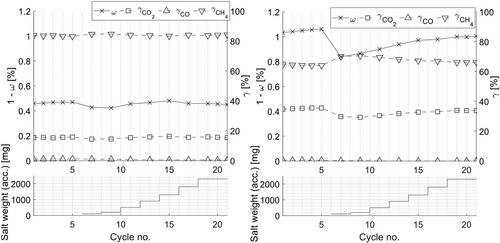下载PDF
{"title":"An improved method for feeding ash model compounds to a bubbling fluidized bed – CLC experiments with ilmenite, methane, and K2CO3","authors":"Felicia Störner, Pavleta Knutsson, Henrik Leion, Tobias Mattisson, Magnus Rydén","doi":"10.1002/ghg.2218","DOIUrl":null,"url":null,"abstract":"<p>Biomass conversion with carbon capture and storage (Bio-Energy CCS; BECCS) is one of the options considered for mitigating climate change. In this paper, the carbon capture technology chemical-looping combustion (CLC) is examined in which the CO<sub>2</sub> is produced in a stream separate from the combustion air. A central research topic for CLC is oxygen carriers; solid metal oxides that provide oxygen for the conversion process. Biomass and waste-derived fuels contain reactive ash compounds, such as potassium, and interactions between the oxygen carrier and the ash species are critical for the lifetime and performance of the oxygen carrier. This work develops and demonstrates an improved method for studying the interactions between ash species and oxygen carriers. The method uses a lab-scale reactor operating under fluidized conditions, simulating CLC batch-wise by switching between feed gas. The novelty of the setup is the integrated system for feeding solid particles of ash model compounds, enabling the simulation of ash species accumulating in the bed. Ilmenite is a benchmark oxygen carrier for solid fuel conversion and was used in this study to evaluate the method using K<sub>2</sub>CO<sub>3</sub> as a model ash compound. Experiments were done at 850 and 950°C. Methane conversion in CLC cycles and fluidization was evaluated with gas analysis and pressure drop measurements. Scanning electron microscopy and energy dispersive X-ray spectroscopy (SEM-EDS) and X-ray diffraction (XRD) analysis of bed particles were done after the experiments to establish changes in the morphology and composition of the ilmenite. The method for feeding the ash model compound was concluded to be satisfactory. At 950°C, K accumulated in the particles forming K-titanates and agglomeration was enhanced with K<sub>2</sub>CO<sub>3</sub> addition. The agglomeration mechanism was solid-state sintering between the Fe-oxides forming on the particle surfaces. The bed defluidized at 950°C, but no such effect was seen at 850°C. The method is suitable for studying the Fe-Ti-K system with ilmenite and potassium without the influence of other ash species. © 2023 The Authors. <i>Greenhouse Gases: Science and Technology</i> published by Society of Chemical Industry and John Wiley & Sons Ltd.</p>","PeriodicalId":12796,"journal":{"name":"Greenhouse Gases: Science and Technology","volume":"13 4","pages":"546-564"},"PeriodicalIF":2.7000,"publicationDate":"2023-04-23","publicationTypes":"Journal Article","fieldsOfStudy":null,"isOpenAccess":false,"openAccessPdf":"https://onlinelibrary.wiley.com/doi/epdf/10.1002/ghg.2218","citationCount":"1","resultStr":null,"platform":"Semanticscholar","paperid":null,"PeriodicalName":"Greenhouse Gases: Science and Technology","FirstCategoryId":"93","ListUrlMain":"https://onlinelibrary.wiley.com/doi/10.1002/ghg.2218","RegionNum":4,"RegionCategory":"环境科学与生态学","ArticlePicture":[],"TitleCN":null,"AbstractTextCN":null,"PMCID":null,"EPubDate":"","PubModel":"","JCR":"Q3","JCRName":"ENERGY & FUELS","Score":null,"Total":0}
引用次数: 1
引用
批量引用
Abstract
Biomass conversion with carbon capture and storage (Bio-Energy CCS; BECCS) is one of the options considered for mitigating climate change. In this paper, the carbon capture technology chemical-looping combustion (CLC) is examined in which the CO2 is produced in a stream separate from the combustion air. A central research topic for CLC is oxygen carriers; solid metal oxides that provide oxygen for the conversion process. Biomass and waste-derived fuels contain reactive ash compounds, such as potassium, and interactions between the oxygen carrier and the ash species are critical for the lifetime and performance of the oxygen carrier. This work develops and demonstrates an improved method for studying the interactions between ash species and oxygen carriers. The method uses a lab-scale reactor operating under fluidized conditions, simulating CLC batch-wise by switching between feed gas. The novelty of the setup is the integrated system for feeding solid particles of ash model compounds, enabling the simulation of ash species accumulating in the bed. Ilmenite is a benchmark oxygen carrier for solid fuel conversion and was used in this study to evaluate the method using K2 CO3 as a model ash compound. Experiments were done at 850 and 950°C. Methane conversion in CLC cycles and fluidization was evaluated with gas analysis and pressure drop measurements. Scanning electron microscopy and energy dispersive X-ray spectroscopy (SEM-EDS) and X-ray diffraction (XRD) analysis of bed particles were done after the experiments to establish changes in the morphology and composition of the ilmenite. The method for feeding the ash model compound was concluded to be satisfactory. At 950°C, K accumulated in the particles forming K-titanates and agglomeration was enhanced with K2 CO3 addition. The agglomeration mechanism was solid-state sintering between the Fe-oxides forming on the particle surfaces. The bed defluidized at 950°C, but no such effect was seen at 850°C. The method is suitable for studying the Fe-Ti-K system with ilmenite and potassium without the influence of other ash species. © 2023 The Authors. Greenhouse Gases: Science and Technology published by Society of Chemical Industry and John Wiley & Sons Ltd.
向鼓泡流化床进料灰分模型化合物的改进方法——钛铁矿、甲烷和k2co3的CLC实验
生物质转化与碳捕获和储存(生物能源CCS;BECCS)是减缓气候变化的备选方案之一。在本文中,研究了碳捕获技术化学循环燃烧(CLC),其中二氧化碳是在与燃烧空气分离的流中产生的。氧载体是CLC研究的中心课题;为转化过程提供氧气的固体金属氧化物。生物质和废物衍生燃料含有活性灰分化合物,如钾,氧载体和灰分之间的相互作用对氧载体的寿命和性能至关重要。这项工作发展并证明了一种改进的方法来研究灰分和氧载体之间的相互作用。该方法使用在流化条件下运行的实验室规模反应器,通过在原料气之间切换来模拟CLC批量。该装置的新颖之处在于其集成的灰模型化合物固体颗粒进料系统,能够模拟在床上积累的灰种。钛铁矿是固体燃料转化的基准氧载体,本研究以K2CO3为模型灰分化合物,对该方法进行了评价。实验分别在850℃和950℃下进行。通过气体分析和压降测量评估了CLC循环和流化过程中的甲烷转化率。实验结束后,通过扫描电子显微镜、x射线能谱仪(SEM-EDS)和x射线衍射仪(XRD)对床层颗粒进行了分析,确定了钛铁矿的形貌和组成的变化。结果表明,灰模型化合物的投料方法是令人满意的。在950℃时,K在颗粒中积累形成K-钛酸盐,并随着K2CO3的加入而增强团聚。颗粒表面形成的铁氧化物之间的团聚机制为固态烧结。床层在950°C时脱流化,但在850°C时没有这种效果。该方法适用于钛铁矿和钾的Fe-Ti-K体系的研究,不受其他灰分的影响。©2023作者。温室气体:科学与技术,化学工业学会和约翰·威利出版社出版;子有限公司
本文章由计算机程序翻译,如有差异,请以英文原文为准。



